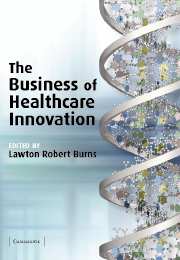Book contents
- Frontmatter
- Contents
- List of figures
- List of contributors
- Preface
- Acknowledgments
- 1 The business of healthcare innovation in the Wharton School curriculum
- Part I The life sciences
- 2 The pharmaceutical sector
- 3 The biotechnology sector – therapeutics
- 4 Biotechnology business and revenue models: the dynamic of technological evolution and capital market ingenuity
- 5 Mergers, acquisitions, and the advantages of scale in the pharmaceutical sector
- Part II Devices and information technologies
- Index
2 - The pharmaceutical sector
Published online by Cambridge University Press: 22 September 2009
- Frontmatter
- Contents
- List of figures
- List of contributors
- Preface
- Acknowledgments
- 1 The business of healthcare innovation in the Wharton School curriculum
- Part I The life sciences
- 2 The pharmaceutical sector
- 3 The biotechnology sector – therapeutics
- 4 Biotechnology business and revenue models: the dynamic of technological evolution and capital market ingenuity
- 5 Mergers, acquisitions, and the advantages of scale in the pharmaceutical sector
- Part II Devices and information technologies
- Index
Summary
Overview of the pharmaceutical sector
Before a study of the pharmaceutical sector can begin, it is necessary that a definition be made of a pharmaceutical.
What is a pharmaceutical?
It has been suggested that a drug is any substance that a scientist uses in a rat to create a scientific paper! A more stringent, and believed more accurate definition is that a pharmaceutical is a drug for human consumption, specifically developed to impact a disease, which goes through the regulatory process designed to approve prescription medications for marketing to physicians.
Thus not included are drug-coated devices, over-the-counter medications, nutritional supplements, generic drugs, or herbs. This is not to imply any attributes, positive or negative, to these categories, but rather to allow focus on the complex and specific business model of discovery, development, manufacture, and marketing of new chemical entities (NCEs) and bioproducts (proteins, peptides, monoclonal antibodies, vaccines, etc.) designed to enhance human health.
New chemical entities
NCEs are small molecules that typically bind to a target and cause a biological process to stop or start. These chemicals are called “small” because they need to be much smaller than proteins in order to be able to be taken orally, then survive the stomach and/or colon, pass into the blood, survive or be appropriately metabolized by the liver, and reach their target in an organ or tissue successfully.
- Type
- Chapter
- Information
- The Business of Healthcare Innovation , pp. 27 - 102Publisher: Cambridge University PressPrint publication year: 2005
- 10
- Cited by



